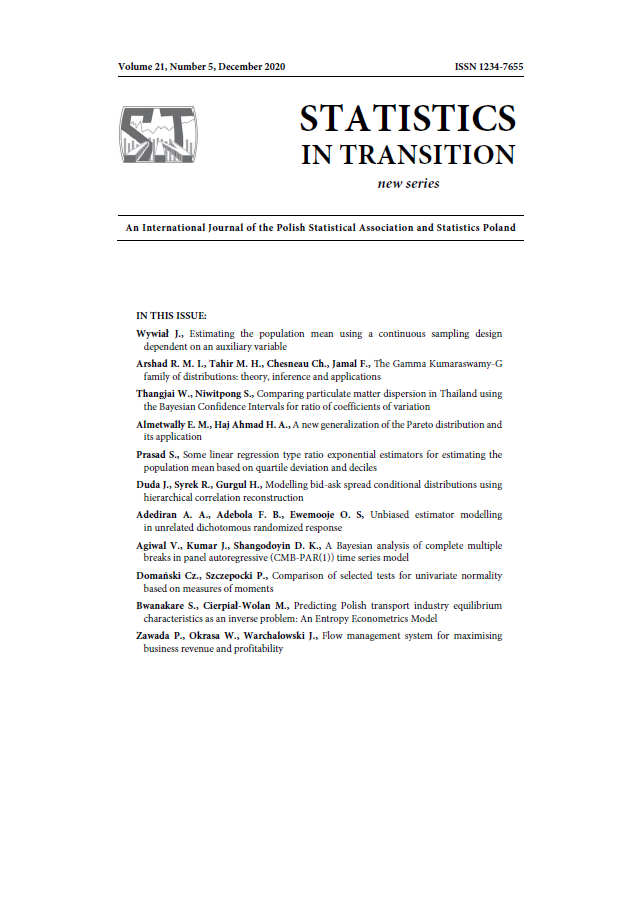ARTICLE
ABSTRACT
Most economic time series, such as GDP, real exchange rate and banking series are irregular by nature as they may be affected by a variety of discrepancies, including political changes, policy reforms, import-export market instability, etc. When such changes entail serious consequences for time series modelling, various researchers manage this problem by applying a structural break. Thus, the aim of this paper is to develop a generalised structural break time series model. The paper discusses a panel autoregressive model with multiple breaks present in all parameters, i.e. in the autoregressive coefficient and mean and error variance, which is a generalisation of various sub-models. The Bayesian approach is applied to estimate the model parameters and to obtain the highest posterior density interval. Strong evidence is observed to support the Bayes estimator and then it is compared with the maximum likelihood estimator. A simulation experiment is conducted and an empirical application on the SARRC association’s GDP per capita time series is used to illustrate the performance of the proposed model. This model is also extended to a temporary shift model. Key words: panel autoregressive model, structural break, MCMC, posterior probability.
KEYWORDS
panel autoregressive model, structural break, MCMC, posterior probability
REFERENCES
AGIWAL, V., KUMAR, J., SHANGODOYIN, D. K., (2018). A Bayesian inference of multiple structural breaks in mean and error variance in panel AR(1) model. Statistics in Transition, 19(1), pp. 7–23.
ALBERT, J. H., CHIB, S., (1993). Bayes inference via Gibbs sampling of autoregressive time series subject to Markov mean and variance shifts. Journal of Business & Economic Statistics, 11(1), pp. 1–15.
ALTISSIMO, F., CORRADI, V., (2003). Strong rules for detecting the number of breaks in a time series. Journal of Econometrics, 117(2), pp. 207–244.
BAI, J., (2010). Common breaks in means and variances for panel data. Journal of Econometrics, 157(1), pp. 78–92.
BAI, J., PERRON, P., (1998). Estimating and testing linear models with multiple structural changes. Econometrica, 66(1), pp. 47–78.
BALTAGI, B. H., FENG, Q., KAO, C., (2016). Estimation of heterogeneous panels with structural breaks. Journal of Econometrics, 191(1), pp. 176–195.
BARDWELL, L., FEARNHEAD, P., ECKLEY, I. A., SMITH, S., SPOTT, M., (2019). Most recent change point detection in panel data. Technometrics, 61(1), pp. 88–98.
CHEN, B., HUANG, L., (2018). Nonparametric testing for smooth structural changes in panel data models. Journal of Econometrics, 202(2), pp. 245–267.
CHIN, W. C., LEE, M. C., YAP, G. L. C., (2016). Heterogeneous autoregressive model with structural break using nearest neighbor truncation volatility estimators for DAX. SpringerPlus, 5, pp. 1–13.
ELLIOTT, G., MULLER, U. K., (2007). Confidence sets for the date of a single break in linear time series regressions. Journal of Econometrics, 141, pp. 1196–1218.
EO, Y., (2012). Bayesian inference about the types of structural breaks when there are different breaks in many parameters. Available at SSRN: http://ssrn. com/abstract, volume 2011825.
GILKS, W. R., RICHARDSON, S., SPIEGELHALTER, D., (1995). Markov chain Monte Carlo in practice. Chapman and Hall/CRC.
HWANG, E., SHIN, D.W., (2017). Stationary bootstrapping for structural break tests for a heterogeneous autoregressive model. Communications for Statistical Applications and Methods, 24(4), pp. 367–382.
JIBRIN, S. A., MUSA, Y., ZUBAIR, U. A., SAIDU, A. S., (2015). ARFIMA modeling and investigation of structural break (s) in West Texas Intermediate and Brent series. CBN Journal of Applied Statistics, 6(2), pp. 59–79.
JIN, B., SHI, X., WU, Y., (2013). A novel and fast methodology for simultaneous multiple structural break estimation and variable selection for nonstationary time series models. Statistics and Computing, 23(2), pp. 1–11.
KARAVIAS, Y., TZAVALIS, E., (2017). Local power of panel unit root tests allowing for structural breaks. Econometric Reviews, 36(10), pp. 1123–1156.
KUMAR, R., KUMAR, J., CHATURVEDI, A., (2012). Bayesian unit root test for time series models with structural break in variance. Journal of Economics and Econometrics, 55(1), pp. 75–86.
MAHEU, J. M., SONG, Y., (2018). An efficient Bayesian approach to multiple structural change in multivariate time series. Journal of Applied Econometrics, 33(2), pp. 251–270.
MELIGKOTSIDOU, L., TZAVALIS, E., VRONTOS, I. D., (2017). On Bayesian analysis and unit root testing for autoregressive models in the presence of multiple structural breaks. Econometrics and Statistics, 4, pp. 70–90.
OKUI, R., WANG, W., (2018). Heterogeneous structural breaks in panel data models. Available at SSRN: https://ssrn.com/abstract=3031689 or http://dx.doi.org/10.2139/ssrn.3031689.
PESARAN, M. H., (2006). Estimation and inference in large heterogeneous panels with multifactor error structure. Econometrica, 74, pp. 967–1012.
PESTOVA, B., PESTA, M., (2017). Change point estimation in panel data without boundary issue. Risks, 5(1), pp.1–22.
TOPÁL, D., MATYASOVSZKYT, I., KERN, Z., HATVANI, I. G., (2016). Detecting breakpoints in artificially modified and real-life time series using three state-of-theart methods. Open Geosciences, 8(1), pp. 78–98.
YAMAMOTO, Y., (2016). A modified confidence set for the structural break date in linear regression models. Econometric Reviews, pp. 1–26.
ZEILEIS, F., LEISCH, K., H., KLEIBER, C., (2002). Strucchange: An R package for testing for structural change in linear regression models. Journal of Statistical Software, 7, pp. 1–38.
